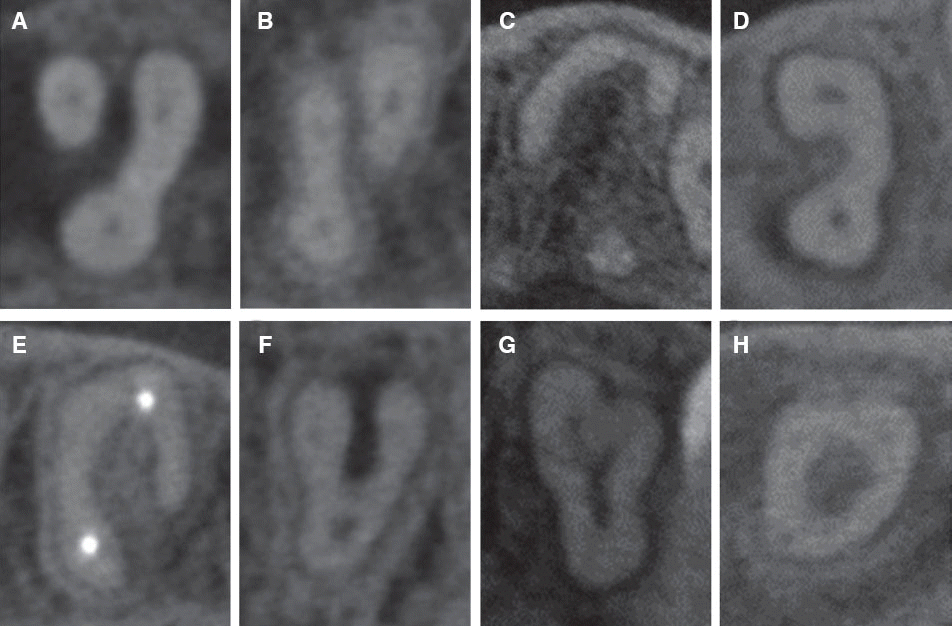2. Aggarwal V, Singla M, Logani A, Shah N. Endodontic management of a maxillary first molar with two palatal canals with the aid of spiral computed tomography: a case report. J Endod. 2009; 35:137–9. DOI:
10.1016/j.joen.2008.10.012. PMID:
19084144.
3. Shin Y, Kim Y, Roh BD. Maxillary first molar with an O-shaped root morphology: report of a case. Int J Oral Sci. 2013; 5:242–4. DOI:
10.1038/ijos.2013.68. PMID:
24008268. PMCID:
PMC3967315.
4. Slowey RR. Radiographic aids in the detection of extra root canals. Oral Surg Oral Med Oral Pathol. 1974; 37:762–72. DOI:
10.1016/0030-y4220(74)90142-X.
7. Hargreaves K, Cohen S. Pathways of the pulp. 2011. 10th ed. St Louis: Mosby;p. 217–9.
8. Baisden MK, Kulild JC, Weller RN. Root canal configuration of the mandibular first premolar. J Endod. 1992; 18:505–8. DOI:
10.1016/S0099-2399(06)81352-X.
9. Rice RT, Gilbert BO Jr. An unusual canal configuration in a mandibular first molar. J Endod. 1987; 13:513–5. DOI:
10.1016/S0099-2399(87)80019-5.
10. Kuzekanani M, Haghani J, Nosrati H. Root and canal morphology of mandibular third molars in an Iranian population. J Dent Res Dent Clin Dent Prospects. 2012; 6:85–8. PMCID:
PMC3442428.
11. Newton CW, McDonald S. A C-shaped canal configuration in a maxillary first molar. J Endod. 1984; 10:397–9. DOI:
10.1016/S0099-2399(84)80162-4.
15. Kato A, Ziegler A, Higuchi N, Nakata K, Nakamura H, Ohno N. Aetiology, incidence and morphology of the C-shaped root canal system and its impact on clinical endodontics. Int Endod J. 2014; 47:1012–33. DOI:
10.1111/iej.12256. PMID:
24483229. PMCID:
PMC4258081.
17. Dankner E, Friedman S, Stabholz A. Bilateral C shaped configuration in maxillary first molars. J Endod. 1990; 16:601–3. DOI:
10.1016/S0099-2399(07)80204-4.
18. Kottoor J, Velmurugan N, Ballal S, Roy A. Fourrooted maxillary first molar having C-shaped palatal root canal morphology evaluated using cone-beam computerized tomography: a case report. Oral Surg Oral Med Oral Pathol Oral Radiol Endod. 2011; 111:e41–5. DOI:
10.1016/j.tripleo.2010.12.009. PMID:
21444221.
20. Cho YH. C-shaped root canal configuration in maxillary molars Master’s thesis. 2013. Chosun University.
21. al Shalabi RM, Omer OE, Glennon J, Jennings M, Claffey NM. Root canal anatomy of maxillary first and second permanent molars. Int Endod J. 2000; 33:405–14. DOI:
10.1046/j.1365-2591.2000.00221.x. PMID:
11307458.
22. Lambrianidis T, Lyroudia K, Pandelidou O, Nicolaou A. Evaluation of periapical radiographs in the recognition of C-shaped mandibular second molars. Int Endod J. 2001; 34:458–62. DOI:
10.1046/j.1365-2591.2001.00417.x. PMID:
11556513.
23. Venskutonis T, Plotino G, Juodzbalys G, Mickevičiene . The importance of cone-beam computed tomography in the management of endodontic problems: a review of the literature. J Endod. 2014; 40:1895–901. DOI:
10.1016/j.joen.2014.05.009. PMID:
25287321.
24. Solomonov M, Paqué F, Fan B, Eilat Y, Berman LH. The challenge of C-shaped canal systems: a comparative study of the self-adjusting file and ProTaper. J Endod. 2012; 38:209–14. DOI:
10.1016/j.joen.2011.10.022. PMID:
22244638.
25. Melton DC, Krell KV, Fuller MW. Anatomical and histological features of C-shaped canals in mandibular second molars. J Endod. 1991; 17:384–8. DOI:
10.1016/S0099-2399(06)81990-4.
28. Ng YL, Aung TH, Alavi A, Gulabivala K. Root and canal morphology of Burmese maxillary molars. Int Endod J. 2001; 34:620–30. DOI:
10.1046/j.1365-2591.2001.00438.x.
29. Kim Y, Lee SJ, Woo J. Morphology of maxillary first and second molars analyzed by cone-beam computed tomography in a Korean population: variations in number of roots and canals and the incidence of fusion. J Endod. 2012; 38:1063–8. DOI:
10.1016/j.joen.2012.04.025. DOI:
10.1016/j.joen.2011.10.023.
30. Plotino G, Tocci L, Grande NM, Testarelli L, Messineo D, Ciotti M, Glassman G, D’ambrosio F, Gambarini G. Symmetry of root and root canal morphology of maxillary and mandibular molars in a white population: a cone-beam computed tomography study in vivo. J Endod. 2013; 12:1545–8. DOI:
10.1016/j.joen.2013.09.012. PMID:
24238444.
31. Matherne RP, Angelopoulos C, Kulild JC, Tira D. Use of cone-beam computed tomography to identify root canal systems in vitro. J Endod. 2008; 34:87–9. DOI:
10.1016/j.joen.2007.10.016. PMID:
18155501.
32. Michetti J, Maret D, Mallet JP, Diemer F. Validation of cone beam computed tomography as a tool to explore root canal anatomy. J Endod. 2010; 36:1187–90. DOI:
10.1016/j.joen.2010.03.029. PMID:
20630296.
33. Patel S, Dawood A, Whaites E, Pitt Ford T. New dimensions in endodontic imaging: part 1 conventional and alternative radiographic systems. Int Endod J. 2009; 42:447–62. DOI:
10.1111/j.1365-2591.2008.01530.x. PMID:
19298577.
34. Palomo JM, Rao PS, Hans MG. Influence of CBCT exposure conditions on radiation dose. Oral Surg Oral Med Oral Pathol Oral Radiol Endod. 2008; 105:773–82. DOI:
10.1016/j.tripleo.2007.12.019. PMID:
18424119.



